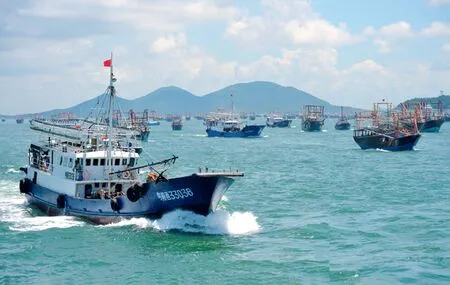Blue Tech Revolution
2012-10-16ByTangYuankai
By Tang Yuankai
Blue Tech Revolution
By Tang Yuankai
Satellite monitoring drives the development of China’s coastal w aters
A nyone who has participated in one of China’s Antarctic scientific expeditions w ill never forget the experience of going through the westerlies.
“Westerly w inds prevail in the region.Cyclones come one after another. In the past,we relied on satellite cloud pictures for w ind information. Whether the icebreakers could go through the westerlies safely mainly depended on luck,” said Jiang Xingwei, Director of the National Satellite Ocean Application Service and chief designer of theHY-2satellite ground application system.
“But now, w ith the new oceanographic satelliteHY-2, the situation has changed. We have real-time, accurate monitoring of the w ind and wave conditions on the sea. Thus vessels can make the best choice in route selection,” said Jiang.
TheHY-2satellite is an important part of China’s civil spacecraft program. The satellite is used to monitor ocean wind fields, sea levels and temperatures, waves, currents, tides,and storms in order to provide disaster and weather forecasting information.
The new sate llite
TheHY-2, which took China Aerospace Science and Technology Corp. 10 years to develop, is China’s first ocean dynam ic environmental survey satellite. It was launched at the Taiyuan Satellite Launch Center on August 16, 2011, and was officially put into use by the State Oceanic Adm inistration of China on March 2.

FOR A M ISSION: Fishing boats set out to sea from Jiangzhapo Port o f south China’s Guangdong Province
To be specific, researchers can determine the environmental information of the fisheries through a combined analysis of the temperature and sea levels monitored byHY-2and the chlorophyll—an element decisive for marine primary productivity—monitored byHY-1B.Thanks to the joint information, researchers are able to get accurate environmental information about the fisheries.
In addition, devices on theHY-2can tell the frontal surface and the mesoscale eddies in the ocean. This information provides meteorological support for fishing activities.
TheHY-2satellite can obtain various ocean dynam ic parameters across the world,including the w ind fields, wave, circulation of the oceans and sea surface temperatures.
It can directly assist in m arine environmental monitoring and prediction,oceanographic research, marine pollution monitoring and oceanic environment changes.
TheHY-2contributes significantly to
It was another milestone in China’s 30-year history of ocean satellite development,said Jiang in Beijing on March 2.
The ocean plays an extremely important role in China’s social and econom ic development and national defense efforts.The Chinese mainland has 10 provinces and municipalities and one autonomous region along the coast. W ith 13.6 percent of China’s territory and 41 percent of its total population,these areas boast more than 60 percent of China’s total wealth.
Currently, the coastal areas are facing prom inent challenges in terms of sustainable development of resources. More than 40 Chinese in-shore fisheries are suffering from over-fishing.
The environmental information provided by theHY-2satellite can inform people of the seasonal changes and the specific layout of fisheries far away from the shore. Thus it can serve as the basis for the government’s fishery policies, said Jiang.
A fter the United Nations Convention on the Law of the Sea entered into force in 1994, many countries started exploring fisheries in the open seas and oceans. Xu Dezhu,a manager of Rongyuan Fishery Co. Ltd.based in east coastal Shandong Province, said China has 200 boats fishing in the open seas around Fiji. Xu said weather determines when and where they should go fishing in the vast ocean.
In the meantime, w ith the help of the satellite, people can choose fish breeding areas more rationally, which w ill help improve the efficiency of the mariculture industry.
On April 11, 2007, China’s second ocean satelliteHY-1Bwas launched. It made up for the shortcom ings ofHY-1A, optim ized technical indicators and improved other functions. W ith its launch, China achieved realtime dynam ic monitoring over the 3-m illionsquare-km sea areas under the jurisdiction of China. A lso, it got real-time environmental information of the Arctic, the Antarctic and other areas such as the Gulf of Aden.
It has now been joined byHY-2. It cooperates w ithHY-1Bto form a threedimensional monitoring system covering both outer space and underwater areas, through the comprehensive use of microwave and optical observations and a combination of dynamic oceanic environmental monitoring and marine resource detection.
Func tions

THE BIG BOOM: The HY-2 satellite is launched on August 16, 2011

STORM IS COM ING: Soldiers of the border police station in Shishi, southeast China’s Fujian Province,lay a p rotec tive net along the sea to p revent travelers from being hurt by an upcom ing storm on August 29, 2011
The new satellite has greatly enhanced China’s ocean m onitoring capabilities.Meanwhile, because it can observe nearly 90 percent of the ocean’s w ind fields, its observation data is an effective complement to the data of global microwave remote sensing satellites.disaster prevention and m itigation. It can provide information on w inds, waves, streams,tides and sea ice for navigation. The satellite effectively monitors changes in the global sea level, theEl Ninophenomena, and changes of polar ice caps as well as extreme oceanic phenomena including storms, typhoons, tsunam is and heavy surfs.
TheHY-2will greatly improve the accuracy and timeliness of the marine environmental forecast. UnlikeHY-1AandHY-1B, which rely on infrared rays and visible light detection, theHY-2depends on active and passive m icrowave remote sensor for detection.
M icrowave remote sensing is a new means of observing the Earth from space.Compared w ith visible light and infrared rays remote sensing, m icrowave remote sensing has unique advantages because it w ill not be affected by cloud, thunder and rain—it can work around the clock in all kinds of weather.
“An active m icrowave remote sensing device is like radar, whose sensor proactively em its electromagnetic waves and receives reflected or scattered electromagnetic waves.Passive m icrowave remote sensing device is like a camera which receives the electromagnetic wave em itted by the surface of the ocean,” said Jiang Jingshan, chief scientist of the National Space Science Center of the Chinese Academy of Sciences (CAS).
HY-2carries four main instruments: a radar altimeter, m icrowave scatterometer,scanning m icrowave radiometer and correction microwave radiometer. The fi rst two are active m icrowave remote sensing devices and the last two are passive m icrowave remote sensing devices. These four instruments, together, play the major role in monitoring and surveying the ocean dynamic environment.
Bene fits
China, lying on the west coast of the Pacific, is subject to oceanic disasters such as storm surges. Every year, China suffers big losses due to these disasters. “W ith typhoons,for example, we could obtain important information only from satellite weather maps, but we could not get accurate information of the changes of w ind vector and waves caused by typhoons,” said Jiang of the CAS.
HY-2can conduct synchronous, real-time and continuous monitoring of a large area of the ocean, and the microwave scatterometer and radar altimeter it carries can solve the problem of monitoring storm surges.
These remote sensors are developed from the multi-molding m icrowave remote sensor carried by China’sShenzhou IVunmanned spaceship that was launched on December 30,2002, and returned on January 5, 2003. The multi-molding m icrowave remote sensor is an important part of the payload of Shenzhou IV and is China’s fi rst experimental m icrowave remote system.
“It has achieved a technical breakthrough,” said Jiang. “The four remote sensors on theHY-2work together to realize a comprehensive remote sensing.”
“China has become the second country that can independently conduct comprehensive m icrow ave remote sensing after the United States,” he said.
The radar altimeter, which operates constantly when the satellite orbits the Earth,has an accuracy of 3-5 centimeters and can measure sea height changes down to the centimeter at an orbit of nearly 1,000 km, said Jiang.
Perhaps for the ordinary people, the technology the professors are developing is irrelevant. But all kinds of oceanographic technology research results are getting closer to the ordinary people. The Outline of the 12th Five-Year Plan for Oceanographic Science and Technology Development (2011-15), which was issued by the State Oceanic Adm inistration and three other m inistries, is very much concerned w ith the livelihood of the people.
In 2003, the State Council approved to launch the 908 Special, a project dedicated to oceanic studies w ith heavy investment. It covers a w ide range of disciplines and adopts the most up-to-date technology. Now the project is coming to a close.
In the past eight years, researchers of the project surveyed the conditions of offshore resources and environm ent, thorough ly updated the basic statistics of offshore environment and compiled relevant atlas series. It has provided scientific support and necessary references for the exploitation of the ocean for the benefi t of the country and the people.
In December 2011, China’s first national-level industry base for the purpose of “exploring the ocean w ith technology”was formally established in Pudong District,Shanghai. In the fi rst half of this year, China’s first “oceanographic technology demonstration island” w ill take shape in Zhoushan, east coastal Zhejiang Province, which w ill be built into a world-class oceanic technology island that takes on such functions as scientific research, entertainment, tourism and ecology.
